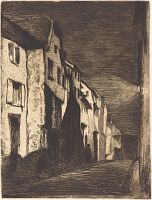Etchings Institutions search term: boston public library
Street at Saverne | ||
| Number: | 14 | |
| Date: | 1858 | |
| Medium: | etching and open bite or sandpaper ground | |
| Size: | 209 x 159 mm | |
| Signed: | 'Whistler' at lower left | |
| Inscribed: | 'Imp. Delatre. Rue St. Jacques' at lower right (2-3); erased (4) | |
| Set/Publication: | 'French Set', 1858 | |
| No. of States: | 4 | |
| Known impressions: | 81 | |
| Catalogues: | K.19; M.19; T.7; W.11 | |
| Impressions taken from this plate (81) | ||
TECHNIQUE
This composition was based on a pencil and wash drawing, A street at Saverne
[m0237]. It may have been etched back in Paris, rather than during the Rhine trip. The etching is the reverse of the drawing, which may have been traced onto the plate.
A variety of techniques were used to vary the textures and depth of shadow. Sandpaper ground or open bite was used in conjunction with horizontal shading on the sky to produce a more regular dark effect, and considerable plate tone was often used on that part of the image. The nocturnal effect was further enhanced by printing some impressions on blue-grey paper (i.e.  ). Pennell commented on the style and printing method used:
). Pennell commented on the style and printing method used:
 ). Pennell commented on the style and printing method used:
). Pennell commented on the style and printing method used:
'Even in this early plate from the French Set there is, with the scrawling sureness and freedom of line,
the real etched lines, and each of the lines means something. Yet it is not immaculate, perfect
work like Meryon's, there is a big mess of foul biting in the foreground and there are passages of
overbiting and underbiting all over the plate. But Whistler with simple lines, though some are unnecessary
and scrawled, got the effect of night, which he was after. I do not know how this plate
was bitten, but I imagine the whole subject was drawn, then the plate put in the bath and then
when slightly bitten the lighter parts stopped out, bitten again, in the old fashioned way, the darks
bitten the longest.' 11
11: Pennell 1919 A , pp. 48-50.
PRINTING
Over seventy impressions of Street at Saverne have been located in public collections. Most impressions - over thirty - are of the third, published, state.
An impression of the first state owned by Samuel Putnam Avery (1822-1904) bears the number '2' in graphite pencil, which may have been written by the artist and refer to the numbering of proofs or states, or be a sales record - it was inscribed and signed by Whistler about 1874 ( ). It is in dark brown ink on cream laid paper with a knobbly texture. Another first state is in dark brown ink on laid paper with a cursive 'P' watermark (
). It is in dark brown ink on cream laid paper with a knobbly texture. Another first state is in dark brown ink on laid paper with a cursive 'P' watermark ( ). A proof of the second state is also in dark brown ink on off-white laid paper (
). A proof of the second state is also in dark brown ink on off-white laid paper ( ).
).
 ). It is in dark brown ink on cream laid paper with a knobbly texture. Another first state is in dark brown ink on laid paper with a cursive 'P' watermark (
). It is in dark brown ink on cream laid paper with a knobbly texture. Another first state is in dark brown ink on laid paper with a cursive 'P' watermark ( ). A proof of the second state is also in dark brown ink on off-white laid paper (
). A proof of the second state is also in dark brown ink on off-white laid paper ( ).
).
'The richness of printing in some of the states of the etching obscured the basic details. Much of the effectiveness of the printing was due to the expertise of the printer, Auguste Delâtre, in manipulating ink on the surface of the plate for expressive effects.' 12
12: Mansfield 1909 (cat. no. 18).


